While the SSC Tuatara boasts an impressive top speed of 295 mph, it falls short of claiming the title for the fastest model on this comprehensive list of supercars and hypercars.
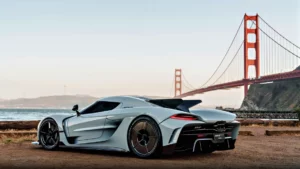
The journey to record-breaking speeds began long ago, with the 1894 Benz Velo holding the distinction of being the first production car to be clocked at a mere 12 mph. Verified speed records remained scarce until approximately 1950 when the Jaguar XK120 set a notable record of 124.6 mph for a production car (not to be confused with a tuned prototype that managed to reach 133 mph). Following this milestone, it became customary for automotive publications to conduct their own independent top speed tests, further fueling the pursuit of velocity in the automotive realm.
The renowned McLaren F1 itself underwent testing by Car and Driver, but it wasn’t until 2005 that we witnessed the first government-official speed record. This feat was accomplished by the Bugatti Veyron EB 16.4 and duly verified by German inspection officials. That groundbreaking moment marked the commencement of an official challenge among manufacturers, sparking a race to break speed records. Since then, only a select few cars have risen to the occasion and pushed the boundaries of velocity. Presented here is a compilation of the top 12 fastest cars in the world, meticulously ranked from the relatively slower to the absolutely swiftest.
Updated June 2023: In the dynamic realm of the automotive industry, constant evolution sees the emergence of an ever-growing fleet of cars, some engineered specifically to shatter records. A noteworthy instance unfolded at the close of 2022 when the Rimac Nevera claimed the title of the fastest electric vehicle (EV) worldwide, clocking an astonishing top speed of 258 mph. This achievement also propelled it into the elite league of the world’s fastest supercars. However, the Rimac Nevera is not the sole contender on this illustrious roster. Without further ado, we unveil the highly anticipated compilation of the 22 swiftest cars in existence, each vying for the pinnacle of speed.
22: B Engineering Edonis
Top Speed: 227 Mph
Among the array of vehicles featured on the list, the B Engineering Edonis stands as a rather enigmatic entry. Originating from the iconic Bugatti EB110 Super Sport of the 1990s, the Edonis showcases a significant overhaul in both its exterior and interior design. While the carbon-fiber chassis remains unchanged from its EB110 SS predecessor, notable enhancements were made to the engine and drivetrain. The Bugatti’s original 3.5-liter V-12 engine underwent a transformation, expanding its displacement to 3.8 liters. Additionally, the quad-turbo configuration gave way to a twin-turbo setup, further refining the Edonis’ performance capabilities.
In a departure from its predecessor, the B Engineering Edonis opted to forgo the all-wheel-drive system, redirecting power exclusively to the rear wheels. The manufacturer claims an impressive top speed of 227 mph (365 km/h) for this remarkable vehicle. However, in real-world testing, the highest achieved top speed reached 222.4 mph (359.6 km/h). It’s worth noting that the Edonis exhibits a slightly longer acceleration time compared to the all-wheel-drive EB110 SS, with a 0 to 60 mph (97 km/h) sprint recorded at approximately 3.9 seconds—a difference of nearly 0.8 seconds.
21: Bugatti EB110 SS Dauer Lightweight
Top Speed: 230 Mph

The 1991 Bugatti EB110 was created to celebrate the 110th anniversary of the brand’s founder, Ettore Bugatti. During the 1990s, Bugatti faced multiple financial challenges and was owned by Romano Artioli at the time. Remarkably, the EB110 was the sole Bugatti model produced under Artioli’s ownership. Following the company’s bankruptcy, German tuner house Dauer Sportwagen acquired all Bugatti assets, including unassembled vehicles that remained from production.
Dauer Sportwagen took the EB110 SS to new heights by crafting five fully carbon fiber models. The engine underwent modifications, resulting in a power boost to 705 horsepower. The acceleration from 0 to 60 mph remained unchanged, but the top speed was raised to 230 mph (370 km/h). While Jochen Dauer claimed a potential top speed of 250 mph (402 km/h), this assertion was never officially verified.
20: Mercedes CLK GTR Super Sport
Top Speed: 232 Mph

In the 1990s and 2000s, remarkable homologation specials made their mark, including Mercedes’ own GT1 racing car. The road-going counterpart, known as the CLK GTR, was an awe-inspiring machine equipped with a mid-mounted M297 V-12 engine. To meet homologation regulations, the car incorporated shared body parts from mass-produced models, such as the front and rear lights directly sourced from the Mercedes CLK C208.
While the interior of the Mercedes CLK GTR bore resemblance to its sedate grand tourer counterpart, the similarities ended there. The production run comprised a total of 28 vehicles, consisting of 20 coupes, six roadsters, and two prototypes. Notably, only five CLK GTRs were equipped with AMG’s Super Sport package, which represented the pinnacle of power for the road-going version of the car.
19: Pagani Huayra R
Top Speed: 238 Mph

Despite being one of the newer players in the supercar realm, Pagani has consistently demonstrated its prowess, leaving no room for underestimation. Hailing from Modena, Italy, this esteemed company has crafted a lineup of extraordinary and formidable high-performance vehicles that captivate the senses. It is safe to assert that not a single model from Pagani can be deemed sluggish, as each one exudes a harmonious blend of beauty and power.
The reigning champion among Pagani supercars in terms of speed is the Huayra R. Unlike its road-legal counterpart, the Huayra R ditches the twin-turbocharged V-12 engine and instead relies on a naturally aspirated 6.0-liter V-12 with a remarkable rev limit of 9,000 RPM. This high-revving powerplant, sourced from AMG, is mated to a six-speed manual transmission, adding to the Huayra R’s unique appeal.
18: McLaren F1
Top Speed: 240 Mph

The McLaren F1, born from the genius of engineer and racing driver Gordon Murray, represents the pursuit of the ultimate supercar. Murray’s relentless dedication ensured no detail was overlooked in its creation. With meticulous engineering, every component of the McLaren F1 served a dual purpose, resulting in a meticulously over-engineered masterpiece. The British supercar featured a BMW-derived V-12 engine, specially tailored for its mid-engine layout. Notably, the engine’s exceptional balance negated the need for a conventional flywheel, ensuring smooth operation.
The McLaren F1, the epitome of analog performance, featured only a six-speed manual transmission. While Gordon Murray didn’t aim for a top speed record, testing the XP5 prototype revealed remarkable speeds. With an average speed of 240.1 mph (386.4 km/h) and a peak of 243 mph (391 km/h), the McLaren F1 remains the fastest naturally-aspirated production car with a manual transmission to this day.
17: Saleen S7 Twin- Turbo
Top Speed: 248 Mph
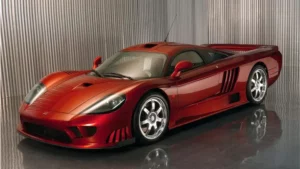
The Saleen S7, an exquisite and rare beauty, stands as a powerful and exceptionally fast supercar. Initially unveiled in 2000, it was later accompanied by the S7 Twin Turbo variant. Both models are equipped with a 7.0-liter V-8 engine that has been enhanced with Garrett twin turbochargers. This upgrade translates to an impressive output of 750 horsepower and 700 pound-feet of torque.
With astounding speed, the S7 Twin Turbo achieves a 0 to 60 mph sprint in a mere 2.7 seconds, accelerating from 0 to 100 mph in just 5.9 seconds. Its quarter-mile time stands at an impressive 10.5 seconds. Notably, this remarkable supercar can reach a top speed of 248 mph. A fun fact worth mentioning is that you may recognize the S7 Twin Turbo from its appearance alongside Jim Carrey in the movie Bruce Almighty.
16: Aspark Owl
Top Speed: 249 Mph

As a highly exclusive offering with a limited production run of just 50 units, the Aspark Owl introduces a multitude of captivating features. Notably, it holds the distinction of being the first-ever fully electric hypercar from Japan, marking a significant milestone. What sets the Owl apart is its unrivaled power, making it the most potent electric vehicle (EV) globally. With the combined might of four permanent magnet synchronous motors, the Aspark Owl boasts an astounding output of 2,012 horsepower.
The Aspark Owl showcases an impressively lightweight carbon fiber chassis, weighing only 264.5 pounds. This exceptional combination of lightness and durability contributes to its astounding speed. With a 0 to 60 mph acceleration time of 1.69 seconds and a claimed top speed of 249 mph, the Owl delivers exhilarating performance. Despite its blistering pace, it manages to offer an impressive all-electric range of 280 miles. However, with a price tag of around $2.8 million, the Aspark Owl falls into the realm of exclusive luxury rather than an affordable option.
15: Aston Martin Valkyrie AMR Pro
Top Speed: 250 Mph

Unveiled at the 2018 Geneva Motor Show, the Aston Martin Valkyrie AMR Pro represents the track-exclusive iteration of the renowned Valkyrie. While sharing the same 6.5-liter naturally aspirated V-12 engine as its road-going counterpart, the Pro model does not feature the KERS system. Nevertheless, the V-12 powerplant remains equally impressive, unleashing a remarkable total of 1,000 horsepower.
Despite slightly lower power than the standard Valkyrie, the Valkyrie AMR Pro compensates with weight-saving measures and aerodynamic enhancements. Utilizing ultra-lightweight carbon-fiber bodywork, carbon suspension springs, and Perspex windshield and side windows, it achieves remarkable speed, topping out at 250 mph. Limited to just 25 units, all allocations for the Valkyrie AMR Pro have already been claimed.
14: McLaren Speedtail
Top Speed: 250 Mph
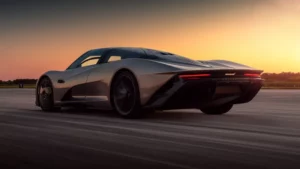
The 2019 McLaren Speedtail, often regarded as the heir to the legendary F1, bears resemblance in its three-seat arrangement with the driver centrally positioned. Setting it apart from fellow contenders, the Speedtail boasts a hybrid powertrain that unites a twin-turbocharged 4.0-liter V-8 gasoline engine with an electric motor. This distinctive combination of combustion and electric propulsion sets the Speedtail apart in its pursuit of extraordinary performance.
McLaren claims that the Speedtail can achieve a remarkable top speed of 250 mph, establishing itself as the fastest vehicle in the company’s lineup. However, at present, McLaren has not provided conclusive evidence to substantiate the Speedtail’s capability to reach these exhilarating speeds.
13: Bugatti Veyron
Top Speed: 253.8 Mph
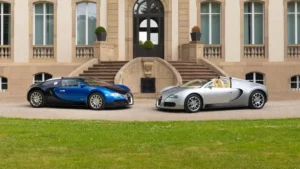
The Bugatti Veyron, our fourth entry on the list, holds the distinction of being the first production car to exceed the 250-mph threshold. In an epic feat that ended McLaren F1’s long-standing record from 1993, the Veyron achieved this milestone in 2005. Powered by an early iteration of the 8.0-liter W-16 engine, the Veyron reached a remarkable top speed of 253.8 mph on April 19, 2005.
Although the Veyron’s record reigned for a mere two years, it was later surpassed by the SuperSport variant and its successor, the Chiron. Notably, this particular Bugatti on our list generates just under 1,000 horsepower. The original Veyron, equipped with a W-16 engine, produces an impressive output of 987 horsepower and 922 pound-feet of torque.
12: Koenigsegg Regera
Top Speed: 255 Mph
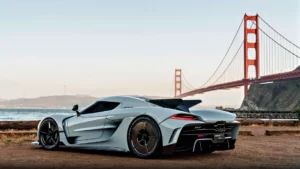
Derived from the Koenigsegg Agera, the Regera stands as a true performance powerhouse. Its propulsion stems from a 5.9-liter V-8 twin-turbocharged engine paired with three electric motors, culminating in an astounding combined output of 1,500 horsepower. Accelerating from 0 to 60 mph in a mere 2.8 seconds, the Regera was purpose-built to shatter records. In 2019, it showcased its dominance by reaching 249 mph in just 31.49 seconds, setting a new world record for the fastest time in a homologated production car. Impressively, the Regera achieved the 0-400-0 km/h feat in 28.81 seconds and 0-250-0 mph in 29.60 seconds.
Impressively, the Koenigsegg Regera achieved an acceleration from 0 to 249 mph in just 22.87 seconds, followed by a deceleration in 8.62 seconds. This remarkable feat was accomplished within a distance of 1,613.2 meters. While Koenigsegg claims a top speed of 255 mph, it should be noted that few will have the opportunity to verify this, as the Regera will be limited to a production run of just 80 units, each priced at $1.5 million.
11: SSC Ultimate Aero
Top Speed: 256 Mph
The Ultimate Aero, for a brief period, claimed the record from the Bugatti Veyron until it was reclaimed by the Veyron Super Sport. In 2007, SSC achieved this feat with a twin-turbo version of their car. The Ultimate Aero reached an impressive top speed of 256.1 mph in West Richland, securing the record until 2010.
After producing several limited-edition models, the Ultimate Aero was discontinued in 2013. However, SSC is currently developing a new contender for the title of the world’s fastest production car, known as the Tuatara. While the record-setting version initially delivered 1,183 horsepower and 1,094 pound-feet of torque, SSC later increased the power output to 1,300 horses. Additionally, they replaced the original 6.3-liter V-8 engine with a larger 6.9-liter variant.
10: Rimac Rivera
Top Speed: 258 Mph
The Rimac Nevera stands as a remarkable electric supercar, boasting an impressive quad-motor configuration that produces an astounding 1,914 horsepower and 1,741 pound-feet of torque. These exceptional numbers firmly establish it as one of the most powerful electric vehicles available today.
With astounding acceleration capabilities, the Rimac Nevera achieves an impressive 0 to 60 mph sprint in just 1.85 seconds, followed by 0 to 100 mph in 4.3 seconds. Initially anticipated to reach a top speed of 256 mph, owners are presently limited to 219 mph. However, in a groundbreaking feat in November 2022, Rimac’s chief test and development driver, Miro Zrnčević, piloted the Nevera to a remarkable top speed of 258 mph. This extraordinary accomplishment solidifies its status as the fastest electric vehicle in the world.
9: Koenigsegg Agera R
Top Speed: 260 Mph
The Agera R, produced between 2011 and 2014, remains an impressive counterpart to the fastest Agera RS. Powered by Koenigsegg’s renowned 5.0-liter V-8 engine, it delivers an astounding output of up to 1,124 horsepower and 885 pound-feet of torque. The Agera R allowed the Swedish automaker to establish several production car records in 2011, although these achievements were later surpassed by the Agera RS.
While the Agera R didn’t claim the top speed record, its remarkable velocity of 260 mph puts it in close proximity to the Bugatti Veyron Super Sport. This notable achievement secures its position as the fifth-fastest car on our list and marks it as the second Koenigsegg model to feature in our top 10.
8: Bugatti Chiron
Top Speed: 261 Mph
Included in our list is the standard Bugatti Chiron, representing the illustrious Bugatti marque. Serving as the successor to the Veyron, the Chiron made its debut in 2016. While maintaining the quad-turbocharged W-16 engine, the Chiron received a significant power boost, resulting in an impressive output of 1,479 horsepower and 1,180 pound-feet of torque.
The standard Bugatti Chiron’s top speed is officially limited to 261 mph, slightly below that of the Veyron Super Sport. However, the Chiron Super Sport claims the top spot on our list, surpassing 300 mph, demonstrating the immense potential lying within its hood.
7: Bugatti Veyron Super Sport
Top Speed: 268 Mph
Despite its 17-year tenure as of 2022, the Bugatti Veyron remains an esteemed contender among the swiftest supercars ever manufactured. The Veyron secures its place on this list with an impressive top speed of 267.8 mph, established by Bugatti in 2010. This extraordinary feat was accomplished with the Veyron Super Sport, a robust variant specially engineered for peak performance.
To commemorate the achievement, Bugatti produced a special series of 30 cars known as the World Record Edition. However, these vehicles were restricted to a top speed of 258 mph to preserve tire integrity. Notably, the Super Sport variant of the Veyron stood as the most potent version, featuring an 8.0-liter W-16 engine that unleashed an impressive 1,184 horsepower, a substantial 197 horsepower increase over the standard model.
6: Hennessey Venom GT
Top Speed: 270 Mph
The limited-production Venom GT, introduced in 2011 and manufactured until 2017, saw only 13 units built. Derived from the Lotus Exige, the Venom GT underwent significant modifications, including an extensively modified twin-turbocharged 7.0-liter V-8 engine. Powered by a highly potent unit based on General Motors’ LS7 V-8, the Venom GT impressively generates up to 1,244 horsepower and 1,155 pound-feet of torque.
In February 2014, the Venom GT achieved its highest top speed of 270.4 mph on Florida’s Kennedy Space Center’s shuttle landing strip. Notably, despite surpassing the existing world record, the run did not meet the requirements for Guinness Book of Records recognition due to being conducted in a single direction. Furthermore, the limited production of only 13 cars contradicted Guinness rules.
5: Koenisegg Agera RS
Top Speed: 278 Mph
In November 2017, the Agera RS, the most powerful iteration of the Agera, claimed the title of the world’s fastest car, achieving an impressive average speed of 277.9 mph. Although its record was surpassed within two years, the Agera RS still retains several noteworthy achievements, firmly establishing its place among the automotive benchmarks.
The Agera RS boasts a range of impressive feats, encompassing swift acceleration from 0 to 200 mph, rapid deceleration from 200 to 0 mph, and the ability to reach 200 mph and come to a complete stop. In contrast to Bugatti’s approach, Koenigsegg did not produce a limited-edition model specifically to commemorate the record. However, the Agera RS was itself limited to just 25 examples, adding to its exclusivity.
4: SSC Tuatara
Top Speed: 295 Mph
Controversy often surrounds top speed records, particularly when attempting to break the seemingly unattainable 300-mph barrier. In October 2020, the SSC Tuatara claimed to have achieved a remarkable speed of 331 mph, surpassing all rivals. However, within hours, discrepancies in the accompanying videos emerged, casting doubt on the validity of the record-breaking run. Subsequently, the claim remained unverified, leaving the quest for the ultimate speed record ongoing.
In their pursuit to establish the Tuatara as the world’s fastest car, SSC made a second attempt. Although it fell short of their initial claim, the endeavor resulted in an official record of 282.6 mph. This achievement propelled the Tuatara ahead of the Koenigsegg Agera RS, securing the second position. However, the Bugatti Chiron Super Sport 300+ retains its status as the current reigning champion of the fastest car in the world.
After numerous controversies surrounding the SSC Tuatara’s top speed claims, the automaker sought to settle the matter once and for all. In a subsequent run, the Tuatara achieved an impressive speed of 295 mph, surpassing its previous record and securing the fourth spot on the list of the world’s fastest cars. While it did not reach the previously speculated speeds of 316 mph or surpass the 300-mph mark, this accomplishment puts skeptics to rest and provides a definitive conclusion.
3: Bugatti Chiron Super Sport 300+
Top Speed: 304 Mph
While the standard Bugatti Chiron already boasts remarkable speed, reaching around 261 mph, the French manufacturer aimed to establish a new record by creating an even more formidable machine. Taking inspiration from the Centodieci, Bugatti integrated a slightly more powerful engine rated at 1,578 horsepower (99 horsepower beyond the standard Chiron). The gearbox was equipped with longer gear ratios, and an updated aerodynamic package was meticulously crafted, resulting in an extended length of nearly 10 inches.
Accelerating to a remarkable top speed of 304.7 mph, the modified Bugatti set a new benchmark. In commemoration of this achievement, Bugatti crafted the Chiron Super Sport 300+, a production model based on the prototype. Restricted to a mere 30 units, this exclusive edition serves to substantiate the speed record and secure its place in the prestigious Guinness World Records.
2: Hennnessey Venom F5
Top Speed: 311 Mph
Renowned for their audacious creations, Hennessey embarked on a remarkable endeavor by crafting a car entirely from the ground up. This endeavor gave birth to the Venom GT in 2011, which remained in production until 2017, albeit with a limited run of just 17 units. In 2016, the automotive world became aware of Hennessey’s plans for the successor to the GT, promising an even more extraordinary model that would surpass its predecessor in every aspect.
Unveiling the highly anticipated successor, the Venom F5, Hennessey delivered an exceptional supercar that surpassed expectations. Equipped with a newly developed V-8 engine, the Venom F5 unleashed an astonishing output of over 1,800 horsepower and nearly 1,200 pound-feet of torque. Power was skillfully transmitted to the rear wheels through a seven-speed automatic transmission. Hennessey confidently asserts that the Venom F5 can achieve a blistering acceleration of under three seconds from 0 to 60 mph and boasts an awe-inspiring top speed of 311 mph.
Continuously refining its performance, the Hennessey Venom F5 has exhibited progress with each successive run, culminating in an impressive speed of 271.6 mph on NASA’s Florida runway. However, Hennessey remains determined to achieve its ultimate objective of 311 mph, and as such, we cannot disregard its potential just yet. The question remains: Will the Hennessey Venom F5 ultimately conquer the monumental milestone of 311 mph? Only time will unveil the answer.
1: Koenisegg Jesko Absolut
Top Speed: 330 Mph
Breaking new ground beyond the already awe-inspiring Jesko, the Swedish automaker introduced a hyper version of their supercar, aptly named the Jesko Absolut. Unveiled in 2020, this extraordinary machine underwent extensive aerodynamic enhancements and enhancements to optimize its high-speed road performance, resulting in unparalleled velocity. The Jesko Absolut achieves an astonishingly low drag coefficient of just 0.278, attributed to strategic modifications such as an elongated rear hood, enclosed rear wheels, and a lowered suspension. Notably, it forgoes front-wheel louvers and massive rear wings, while the front hood air ducts remain sealed.
Boasting an astounding 1,600 horsepower and priced at $2.8 million, the Absolut Jesko commands attention with its claimed top speed of 330 mph. However, it is important to acknowledge that this figure remains theoretical, as the car has yet to achieve it in real-world conditions. Nevertheless, there is anticipation that the Absolut Jesko will soon make its debut on the open road, following the release of the first model in May 2022. With hopes of avoiding any unfortunate controversies akin to the Tuatara, for now, we trust in Koenigsegg’s assertion and acknowledge its claim to the throne as the world’s fastest car.
